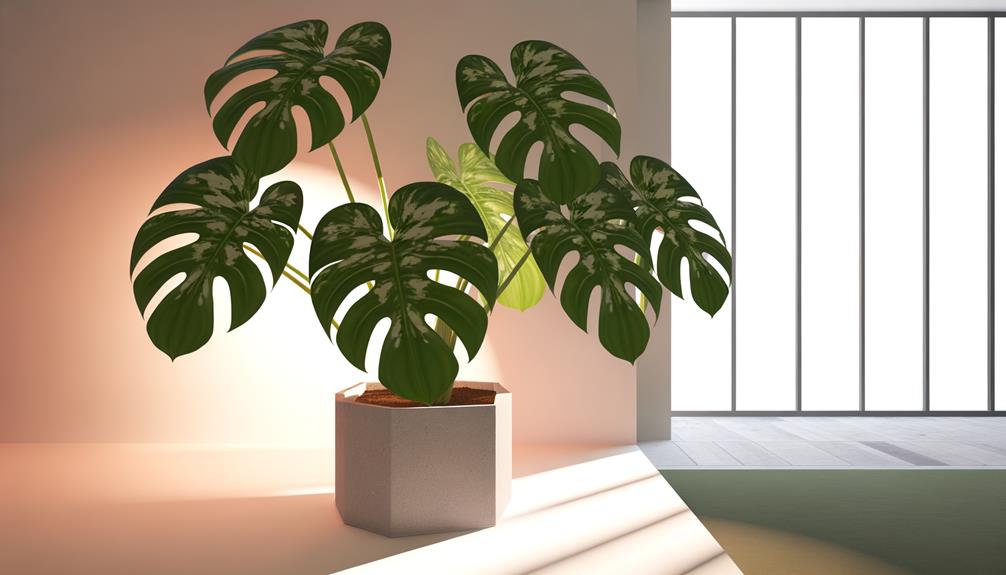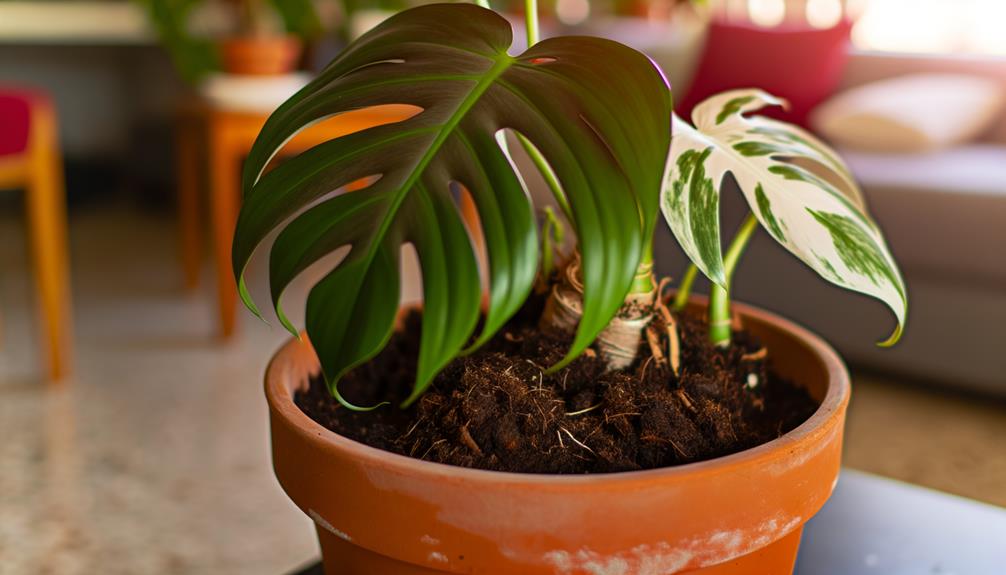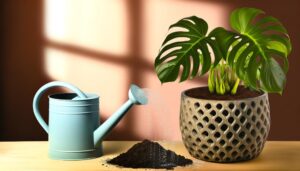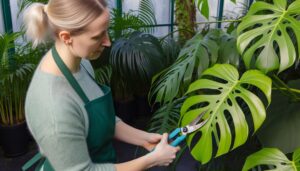Monstera Standleyana Albo Variegata Care
To care for your Monstera Standleyana Albo Variegata, position it in bright, indirect light, ideally near an east or north-facing window. Use a light meter to make sure it receives 10,000 to 20,000 lux.
Water consistently, allowing the top 1-2 inches of soil to dry out. Use well-draining soil rich in organic matter, like a mix of peat moss, perlite, and pine bark.
Maintain humidity levels between 60-80% using humidifiers or misting. For propagation, take stem cuttings with nodes and aerial roots, keeping them in indirect sunlight until roots develop.
Learn the intricacies of its needs for lush, healthy growth.

Key Takeaways
- Provide bright, indirect light and avoid direct sunlight to prevent leaf damage.
- Water when the top 1-2 inches of soil are dry, avoiding over-watering.
- Use well-draining, aerated soil rich in organic matter for optimal growth.
- Maintain high humidity levels between 60-80% with humidifiers or misting.
- Propagate using healthy stem cuttings with nodes, ensuring high humidity for root development.
Light Requirements

For ideal growth, Monstera Standleyana Albo Variegata requires bright, indirect light, mimicking the dappled sunlight of its native tropical understory. You should position your plant near an east or north-facing window, ensuring it receives approximately 10,000 to 20,000 lux.
Direct sunlight can cause photodamage to the variegated leaves, leading to chlorophyll degradation and leaf burn. Use a light meter to precisely measure light levels.
Inadequate light exposure inhibits photosynthesis, resulting in stunted growth and loss of variegation. If natural light is insufficient, you can supplement with full-spectrum LED grow lights, set to 12-14 hours daily.
Watering Routine
Ensuring the Monstera Standleyana Albo Variegata receives proper hydration involves maintaining a consistent watering schedule that keeps the soil moist but not waterlogged, preventing root rot and other moisture-related issues.
You should water when the top 1-2 inches of soil feel dry to the touch, utilizing a moisture meter for precision. Over-watering can lead to fungal infections and necrosis of the root system. Conversely, under-watering may cause leaf curling and brown edges.
Aim for a balance, considering environmental factors like humidity and temperature, which affect evaporation rates and plant water uptake (Taiz and Zeiger, 2010).
During the growing season, increase watering frequency, while in winter, reduce it to match the plant's dormancy phase.
Soil Preferences

Selecting the right soil mix for Monstera Standleyana Albo Variegata is crucial, as it requires well-draining, aerated soil rich in organic matter to support healthy root development and prevent waterlogging (Bunt, 2012). You should use a blend that combines peat moss, perlite, and pine bark. This mix guarantees both moisture retention and proper aeration.
| Component | Function |
|---|---|
| Peat Moss | Retains moisture, enriches |
| Perlite | Enhances drainage, aeration |
| Pine Bark | Provides structure, aeration |
| Compost | Adds nutrients, organic matter |
| Sand | Improves drainage |
Avoid heavy, clay-based soils, as they can retain excessive moisture and lead to root rot. Regularly check the soil's consistency and adjust as needed to maintain an ideal growing environment.
Humidity Needs
Why is maintaining high humidity necessary for the best growth of Monstera Standleyana Albo Variegata?
High humidity mimics the plant's natural tropical environment, ensuring optimal physiological processes like transpiration and photosynthesis.
Consistently high humidity helps prevent issues such as leaf browning and stunted growth.
Here's how to maintain ideal humidity levels:
- Humidity Trays: Place a tray filled with water and pebbles beneath the plant pot to increase ambient moisture.
- Humidifiers: Use a humidifier to maintain humidity levels between 60-80%, important for Monstera's health.
- Misting: Regular misting with distilled water can provide temporary humidity boosts, particularly in drier climates.
These methods support the plant's metabolic activities, ensuring lush and vibrant foliage.
Propagation Tips

To successfully propagate Monstera Standleyana Albo Variegata, start by taking healthy stem cuttings with at least one node and aerial root. Utilize sterilized pruning shears to minimize the risk of infection (Chaparro et al., 2020). Place the cutting in water or a sphagnum moss medium to encourage root development.
Maintain the environment with high humidity, around 60-80%, to facilitate optimal growth conditions (Smith, 2019). Position the cutting in indirect sunlight; too much direct light can cause variegated leaves to scorch (Jones & Harrison, 2021).
Change the water every few days to prevent bacterial growth if using a water medium. Transplant the cutting into well-draining soil once roots are 2-3 inches long, ensuring continued root health.
Conclusion
In caring for your Monstera standleyana albo variegata, think of yourself as a symphony conductor, harmonizing light, water, soil, and humidity.
Guarantee it bathes in indirect light, drinks moderately, and roots in well-draining soil. Maintain humidity levels akin to a rainforest.
With precise propagation techniques, you'll multiply its beauty. Master these elements, and your plant will flourish like a well-composed masterpiece, scientifically thriving under your meticulous care.
Remember, every detail counts in this botanical symphony.





